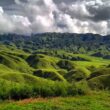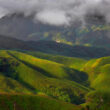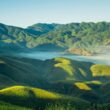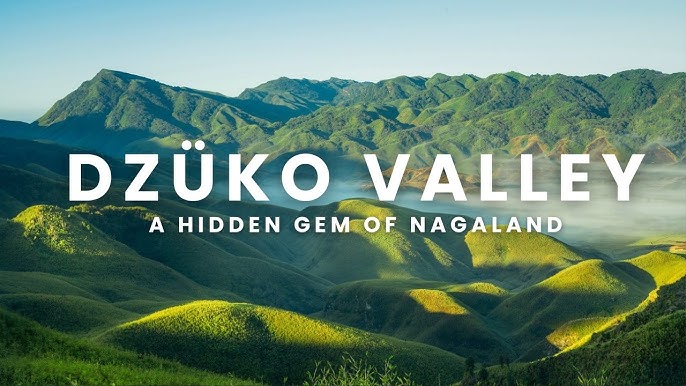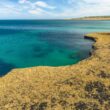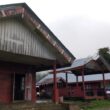Nestled between Nagaland and Manipur, the Dzukou Valley is often called the “Valley of Flowers of the Northeast.” This surreal paradise sits at an altitude of around 2,452 meters and is famous for its rolling green meadows, vibrant seasonal flowers—especially the rare Dzukou lily—and panoramic landscapes. Dzukou Valley Trek.
Trekking here is a bucket-list experience for nature lovers, photographers, and adventure seekers looking for an offbeat trail in India. This guide will walk you through everything you need: the best time to visit, routes, and what to pack.
Best Time to Visit Dzukou Valley
Summer (May to June):
- Why Go: This is when the valley bursts into life with countless wildflowers carpeting the slopes. The famous Dzukou lily blooms during this time.
- Weather: Pleasant, with temperatures between 11°C to 20°C.
- Tip: Start early to avoid mid-day heat.
Monsoon (July to September):
- Why Go: If you love misty trails and lush greenery, monsoon is spectacular.
- Weather: Rainy and slippery. Visibility can be low.
- Tip: Only experienced trekkers should attempt the trek during this time.
Autumn (October to November):
- Why Go: Clear skies, crisp air, and golden hues of grasslands.
- Weather: Cool and refreshing, perfect for photography.
- Tip: This is the most comfortable time for beginners.
Winter (December to February):
- Why Go: Snow blankets the valley, transforming it into a fairytale landscape.
- Weather: Freezing, with temperatures dropping below zero.
- Tip: Carry proper winter trekking gear.
Verdict:
June and October are the most popular months to experience the valley at its best.
Dzukou Valley Trek Routes
There are two main routes to access the Dzukou Valley:
1. Viswema Route (Nagaland)
Overview:
- The most preferred and easier trail.
- Ideal for beginners.
Starting Point:
- Viswema Village, about 25 km from Kohima.
Route Highlights:
- From Viswema, you can hire a local vehicle up to the trekking point.
- The initial ascent is moderately steep (around 5 km).
- After the climb, a flat trail leads to the valley’s base camp.
- Total Trek Time: 4–5 hours.
Pro Tip:
- If you’re short on time, Viswema route is faster and less strenuous.
2. Zakhama Route (Nagaland)
Overview:
- Steeper and more challenging.
- Great for experienced trekkers.
Starting Point:
- Zakhama Village, near Kohima.
Route Highlights:
- The trail is steep right from the beginning.
- Dense bamboo forests and narrow rocky paths.
- More scenic, with less footfall compared to Viswema.
Total Trek Time:
- 5–7 hours depending on pace.
Pro Tip:
- Zakhama route is more adventurous and rewarding but requires good fitness.
How to Reach Dzukou Valley
Nearest Airport:
- Dimapur Airport (74 km from Kohima).
Nearest Railway Station:
- Dimapur Railway Station.
By Road:
- Take a shared taxi or private vehicle from Dimapur to Kohima.
- From Kohima, hire a local taxi to Viswema or Zakhama.
Permit Requirements:
- Inner Line Permit (ILP) is mandatory for Indian tourists visiting Nagaland.
- Foreigners must register with the Foreigners’ Registration Officer.
- Carry identity proof and passport-size photographs.
What to Pack for the Dzukou Valley Trek
Packing right is crucial as the terrain and weather can change quickly. Here’s your essential packing checklist:
Clothing
- Lightweight, quick-dry trekking pants.
- Full-sleeve moisture-wicking T-shirts.
- Thermal layers (if traveling in winter).
- Fleece or down jacket.
- Waterproof windcheater or poncho.
- Extra socks and undergarments.
- Woolen cap and gloves (for winter months).
Footwear
- Sturdy trekking boots with good grip.
- Comfortable sandals for the campsite.
Gear
- Backpack (50–60 liters).
- Rain cover for backpack.
- Trekking poles (helpful for steep climbs).
- Sleeping bag (rated for sub-zero temperatures in winter).
Health & Hygiene
- Reusable water bottles or hydration pack.
- Water purification tablets.
- First-aid kit (pain relievers, antiseptic, blister plasters).
- Sunscreen, lip balm, sunglasses.
- Personal toiletries and biodegradable soap.
- Toilet paper and wet wipes.
Food & Snacks
- Energy bars, nuts, trail mix.
- Ready-to-eat meals or instant noodles.
- Thermos flask (great for hot beverages).
Miscellaneous
- Headlamp or flashlight with extra batteries.
- Power bank for charging devices.
- Camera with spare memory cards.
- Identity documents and permits.
Tips to Make Your Trek Safe and Enjoyable
✅ Acclimatize in Kohima for a day before starting the trek to avoid altitude sickness.
✅ Start early in the morning to reach the valley before sunset.
✅ Hire a local guide if you are unfamiliar with the trail.
✅ Respect local customs and environment—carry back all plastic waste.
✅ Avoid monsoon treks unless you have prior experience.

